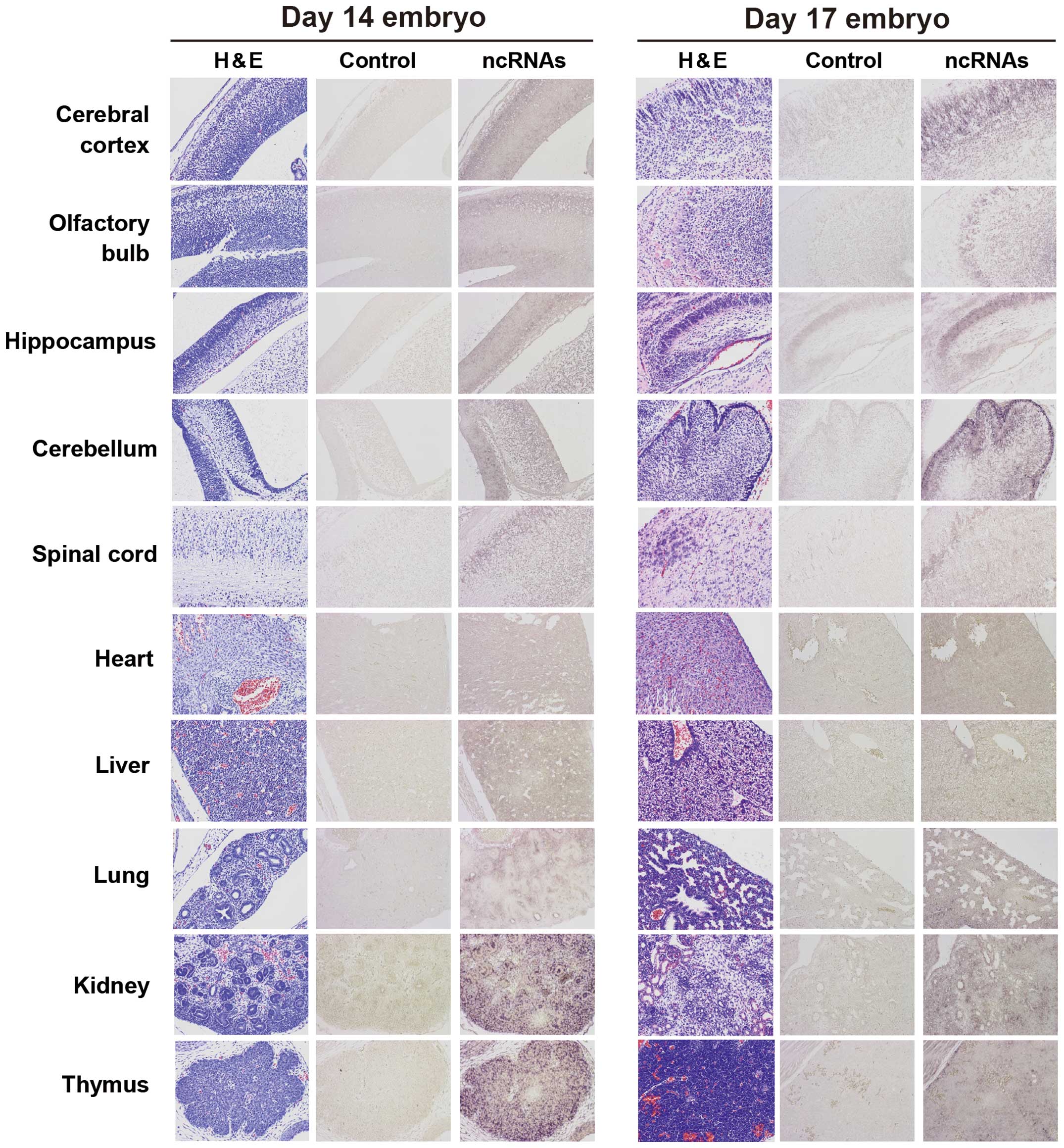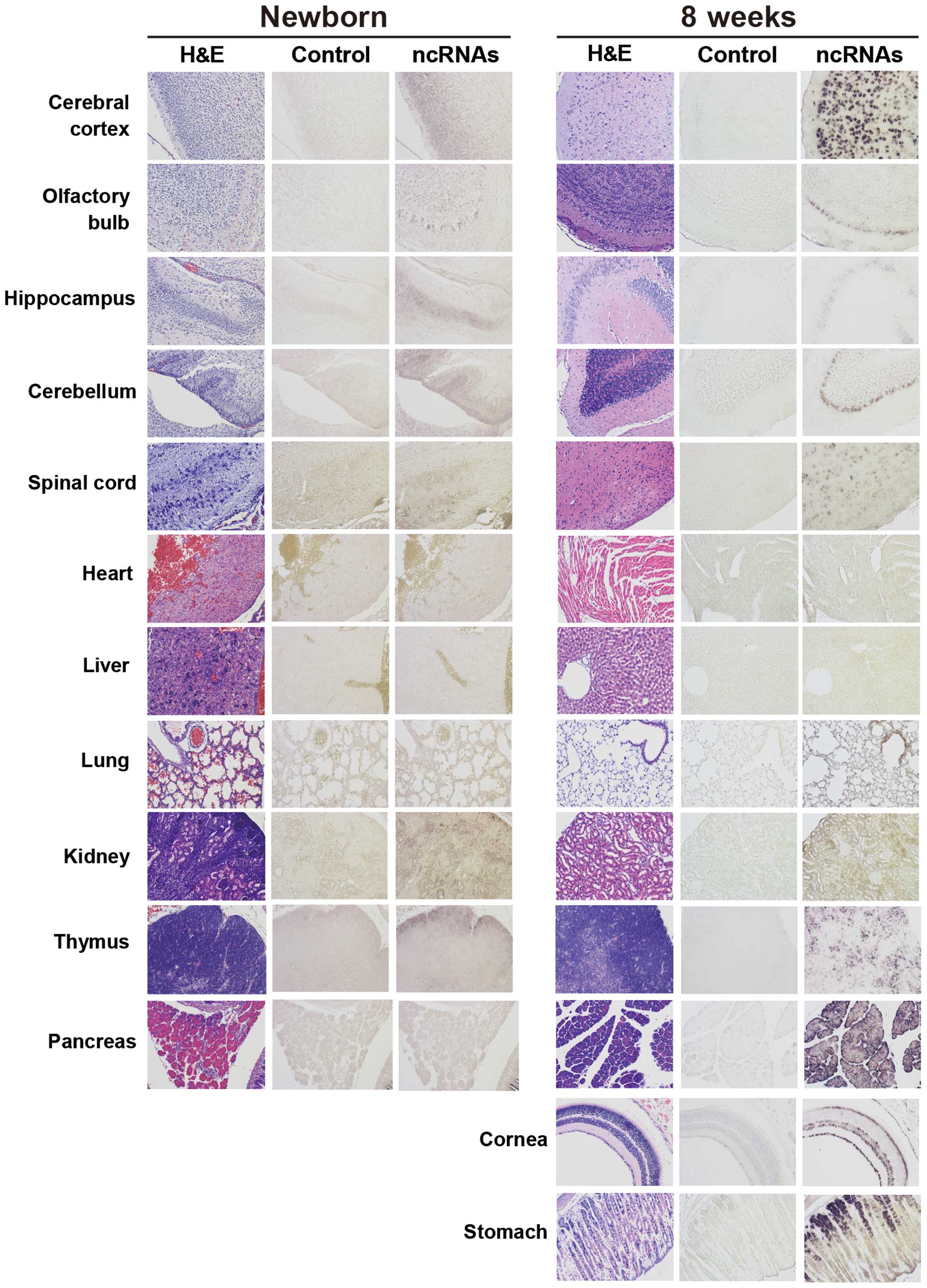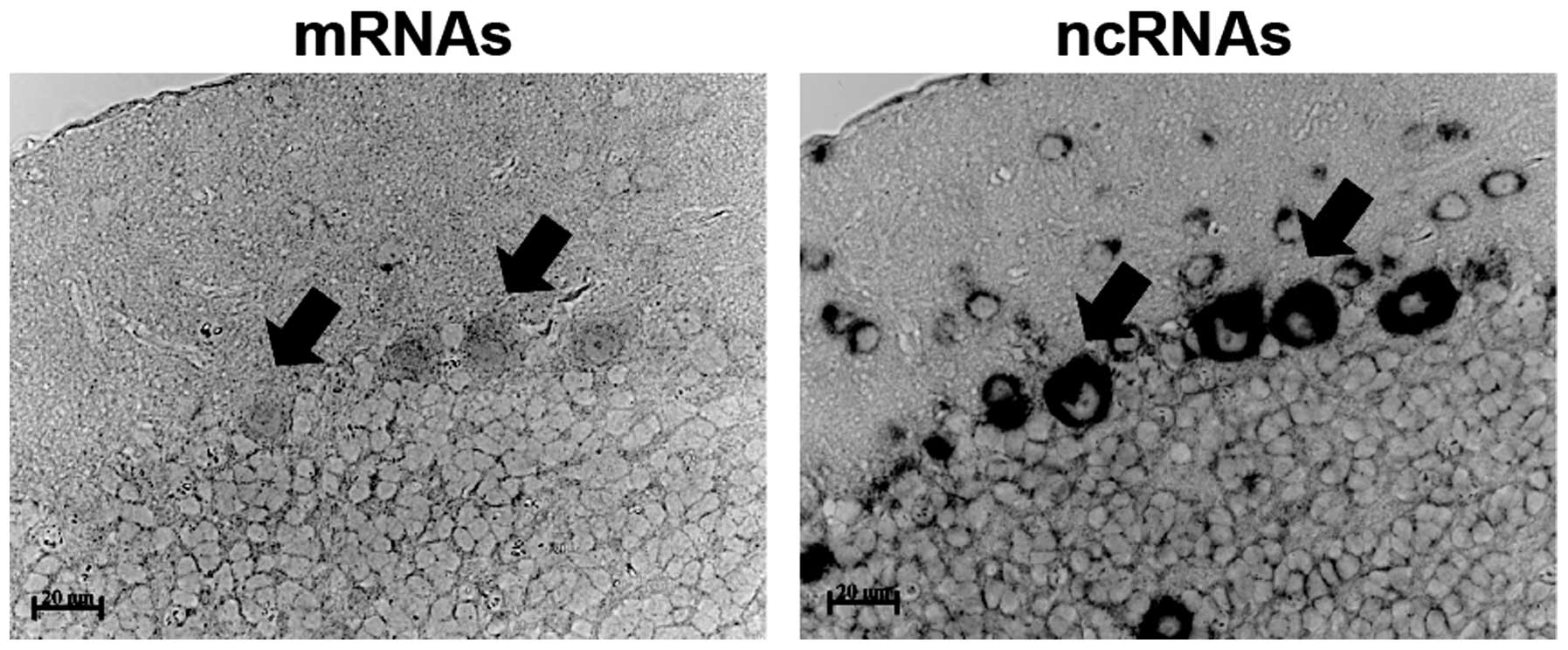Detection of natural antisense non-coding RNAs transcribed from Ncam1 in mice tissues at several developmental stages
- Authors:
- Published online on: June 29, 2015 https://doi.org/10.3892/br.2015.482
- Pages: 663-667
Abstract
Introduction
Natural antisense ribonucleic acids (RNAs) are transcripts that contain sequences complementary to other endogenous RNAs including messenger RNAs (mRNAs). Kiyosawa et al (1,2) identified ~2,500 complementary deoxyribonucleic acid (cDNA) pairs originating from opposite strands of the same genomic loci by mapping these cDNAs to the draft mouse genome sequence. The functional annotation of the mammalian genome (FANTOM) cDNA dataset contained numerous non-coding RNAs (ncRNAs) (1–3). More than 70% of the antisense pairs identified by Kiyosawa et al (1,2) included ncRNAs as one of the members in the pair. To date, a number of mammalian antisense ncRNAs have been found, indicating that antisense transcription may be a commonly employed mechanism to regulate gene expression in human cells (1–5). Faghihi et al (6) reviewed the functions of known antisense ncRNAs, such as transcriptional interference, genomic imprinting, X chromosome inactivation and alternative splicing. Certain investigators have reported that the gene expression of antisense ncRNAs was up- or downregulated under conditions of physiological change, such as the development of various types of cancer (7,8). However, it is difficult to elucidate the function of antisense ncRNAs via gene expression analyses, such as microarrays.
The neural cell adhesion molecule 1 (Ncam1, also known as CD56) gene encodes a cell adhesion protein and is a member of the immunoglobulin superfamily. The encoded protein is involved in cell-to-cell and cell-matrix interactions during development and differentiation, as well as nervous system development (9,10). Antisense ncRNAs from opposite strands of the Ncam1 loci in mice have been registered in the NCBI database (http://www.ncbi.nlm.nih.gov/gene/100036537) and antisense viewer (http://genome.gsc.riken.jp/m/antisense). In addition, the expression of antisense ncRNAs from Ncam1 loci in the brain has been proven using microarray analysis by Kiyosawa et al (2). However, the expression and localization of this ncRNAs in other tissues remains unclear.
It is necessary to examine the cells and/or tissues from which the ncRNAs are expressed in order to understand the role of Ncam1 antisense ncRNAs. In the present study, the expression of Ncam1 antisense ncRNAs was examined in mice tissues at different developmental stages by in situ hybridization.
Materials and methods
Sections of the embryo and tissues
C57BL/6J mice at different developmental stages (at day 14 of mouse embryo development, E14; day 17 of development, E17; and newborn mice; 8-week-old mice) were obtained from the RIKEN BioResource Center (Ibaraki, Japan).
For in situ hybridization, tissues from mice at different developmental stages were first fixed in situ by perfusion with 4% (w/v) ice-cold paraformaldehyde solution in phosphate-buffered saline (PBS). The resulting tissues were excised and further fixed overnight in the paraformaldehyde solution. The fixed tissues were embedded in paraffin and 4 µm sections were cut. Sections were placed on glass slides and subjected to in situ hybridization.
Complementary RNA (cRNA) probe
For Ncam1 antisense ncRNAs and mRNAs, probes with a specific sequence: 5′-ATCTGGTCAAGTACAGAGCGCTCGCCTCTGAGTGGAAACCGGAAATCAGGCTCCCATCCGGCAGTGACGACCACGTCATGCTCAAGTCCCTGGACTGGAACGCAGAGTATGAAGTCTATG T-3′; and a size of 118 nucleotides were designed in the mRNAs of Ncam1. As a control RNA probe, a 120-nucleotide λ-phage sequence that had no similarity with any of the mammalian sequences registered in the DNA Data Bank of Japan (www.ddbj.nig.ac.jp/index-j.html) was used in all the in situ hybridization experiments to verify that the hybridization system did not emit any non-specific hybridization signals. Digoxigenin (DIG)-labeled cRNA probes were provided by Tsukuba GeneTech Laboratories (Ibaraki, Japan).
In situ hybridization
Sections of embryos and tissues on glass slides were deparrafinized with xylene and ethanol, washed in PBS and incubated in PBS containing 1.0 µg/ml proteinase K, at 37°C for 15 min. The slides were washed in PBS and treated with 0.1 M triethanolamine in 0.25% acetic anhydride for 15 min. Slides were subsequently washed with 0.1 M triethanolamine and 4X standard saline citrate (SSC), and incubated in prehybridization solution (50% formamide, 2X SSC) at 42°C for 30 min. Hybridization was performed in a solution containing 50% formamide, 2X SSC, 1.0 mg/ml transfer RNA (tRNA), 1.0 mg/ml salmon DNA, 1.0 mg/ml bovine serum albumin, 1.0% sodium dodecyl sulfate and 3.0 µg/ml DIG-labeled sense or antisense cRNA probes, at 42°C for 16 h.
The resulting slides were successively washed with prehybridization solution, 0.2X SSC and 0.1X SSC, at 42°C, followed by treatment with NT buffer [150 mmol/l NaCl and 100 mmol/l Tris-HCl (pH 7.5)] containing 10% fetal bovine serum, 1% blocking reagent (Roche Diagnostics, Basel, Switzerland) and 1 mg/ml tRNA, for 30 min. Subsequently, hybridization signals were visualized using the alkaline phosphatase-labeled anti-DIG antibody/nitro blue tetrazolium chloride 5-bromo-4-chloro-3-indolyl-phosphate system (Roche Diagnostics).
Results and Discussion
Recently, antisense ncRNAs from a number of genes have been identified in mice and humans using bioinformatic and microarray analyses. Antisense ncRNAs have been inferred to be involved in the control of trait expression in mammals, including humans, mice and livestock. Study of the sites of antisense ncRNA expression in tissues would provide important information regarding the functions of antisense ncRNAs in mice. Therefore, mice were used in the present study to investigate the expression sites of previously described antisense ncRNAs from Ncam1.
Kiyosawa et al (2) examined sense/antisense expression using a custom microarray with different cDNA priming methods. Ncam1 antisense ncRNAs in the brain were more strongly expressed than those mRNAs in the microarray analysis using oligo(dT) or random nonamer primers (Fig. 1). Microarray analysis using oligo(dT) primers is assumed to detect RNAs (transcripts) with poly(A) tails, whereas microarray analysis using random nonamer primers is assumed to detect RNAs with and without poly(A) tails. This information suggests that Ncam1 antisense ncRNAs may have poly(A) tails.
To date, the open reading frame, or protein-coding region, of Ncam1 antisense RNAs has not been confirmed in several databases, including FANTOM. Therefore, Ncam1 antisense RNAs are ncRNAs. To examine the expression and localization of Ncam1 antisense ncRNAs at different developmental stages, in situ hybridization was performed. In situ hybridization is known to detect RNAs with and without poly(A) tails. Therefore, it is generally considered that the signal intensity patterns of in situ hybridization are the same as those of microarray analysis using random nonamer primers.
In E14 embryos, Ncam1 antisense ncRNAs were uniformly detected in the heart, liver and nervous system regions, including the brain, and were detected at high levels in certain regions of the lung, kidney and thymus (Fig. 2). In E17 embryos, Ncam1 antisense ncRNAs were detected at high levels in specific cells of the brain, whereas they were uniformly detected in other tissues (heart, liver, lung, kidney and thymus). In newborn mice, Ncam1 antisense ncRNAs were weakly detected in the brain, kidney and thymus. The transcription pattern of NB mice was similar to that of E17 embryos, except that the signals in organs other than the brain were weaker than those of the E17 embryos (Figs. 2 and 3). In the 8-week-old mice, Ncam1 antisense ncRNAs were detected at high levels in limited regions of the brain, stomach, cornea and all the regions of the pancreas. Contrastingly, they were detected at low levels in the remaining organs that were examined, excluding the liver. With regards to the liver, negligible amounts of Ncam1 antisense ncRNA expression was detected (Fig. 3). These results indicate that Ncam1 antisense ncRNAs are expressed in mice tissues.
Of note, Ncam1 mRNAs and antisense ncRNAs co-localized in Purkinje cells of the cerebellum and the levels of antisense ncRNAs appeared to be higher than those of mRNAs (Fig. 4). Based on the patterns of the in situ hybridization signals for Ncam1 antisense ncRNAs detected in tissues, some potential functions were identified for Ncam1 antisense ncRNAs. In the analysis of the adjacent sections, Ncam1 mRNAs were detected in some of the brain cells found to produce Ncam1 antisense ncRNAs. This indicates that Ncam1 antisense ncRNAs may control the function of Ncam1 mRNAs, as previously proposed in reviews on other antisense ncRNAs (6,11). Currently, the exact function of Ncam1 antisense ncRNAs in each tissue is unknown. However, the expression patterns of Ncam1 antisense ncRNAs may provide information for understanding their function. In future studies, the interactions between Ncam1 mRNAs and antisense ncRNAs should be examined.
Acknowledgements
The author would like to thank Dr Hiroshi Yasue of Tsukuba GeneTech Laboratories (Ibaraki, Japan) for the provision of DIG-labeled cRNA probes and Ms. Noriko Hiraiwa of RIKEN BioResource Center for offering the samples. The present study was supported in part by the Grants in Aid from the Ministry of Education, Culture, Sports, Science and Technology of Japan and the Hirosaki University Grant for Exploratory Research by Young Scientists.
References
|
Kiyosawa H, Yamanaka I, Osato N, Kondo S and Hayashizaki YRIKEN GER Group: Role: GSL MembersAntisense transcripts with FANTOM2 clone set and their implications for gene regulation. Genome Res. 13((6B)): 1324–1334. 2003. View Article : Google Scholar : PubMed/NCBI | |
|
Kiyosawa H, Mise N, Iwase S, Hayashizaki Y and Abe K: Disclosing hidden transcripts: Mouse natural sense-antisense transcripts tend to be poly(A) negative and nuclear localized. Genome Res. 15:463–474. 2005. View Article : Google Scholar : PubMed/NCBI | |
|
Okazaki Y, Furuno M, Kasukawa T, Adachi J, Bono H, Kondo S, Nikaido I, Osato N, Saito R, Suzuki H, et al FANTOM Consortium; RIKEN Genome Exploration Research Group Phase I & II Team: Analysis of the mouse transcriptome based on functional annotation of 60,770 full-length cDNAs. Nature. 420:563–573. 2002. View Article : Google Scholar : PubMed/NCBI | |
|
Katayama S, Tomaru Y, Kasukawa T, Waki K, Nakanishi M, Nakamura M, Nishida H, Yap CC, Suzuki M, Kawai J, et al FANTOM Consortium: Antisense transcription in the mammalian transcriptome. Science. 309:1564–1566. 2005. View Article : Google Scholar : PubMed/NCBI | |
|
Lehner B, Williams G, Campbell RD and Sanderson CM: Antisense transcripts in the human genome. Trends Genet. 18:63–65. 2002. View Article : Google Scholar : PubMed/NCBI | |
|
Faghihi MA and Wahlestedt C: Regulatory roles of natural antisense transcripts. Nat Rev Mol Cell Biol. 10:637–643. 2009. View Article : Google Scholar : PubMed/NCBI | |
|
Kohno K, Chiba M, Murata S, Pak S, Nagai K, Yamamoto M, Yanagisawa K, Kobayashi A, Yasue H and Ohkohchi N: Identification of natural antisense transcripts involved in human colorectal cancer development. Int J Oncol. 37:1425–1432. 2010.PubMed/NCBI | |
|
Grigoriadis A, Oliver GR, Tanney A, Kendrick H, Smalley MJ, Jat P and Neville AM: Identification of differentially expressed sense and antisense transcript pairs in breast epithelial tissues. BMC Genomics. 10:3242009. View Article : Google Scholar : PubMed/NCBI | |
|
Cremer H, Lange R, Christoph A, Plomann M, Vopper G, Roes J, Brown R, Baldwin S, Kraemer P, Scheff S, et al: Inactivation of the N-CAM gene in mice results in size reduction of the olfactory bulb and deficits in spatial learning. Nature. 367:455–459. 1994. View Article : Google Scholar : PubMed/NCBI | |
|
Dityatev A, Dityateva G, Sytnyk V, Delling M, Toni N, Nikonenko I, Muller D and Schachner M: Polysialylated neural cell adhesion molecule promotes remodeling and formation of hippocampal synapses. J Neurosci. 24:9372–9382. 2004. View Article : Google Scholar : PubMed/NCBI | |
|
Lavorgna G, Dahary D, Lehner B, Sorek R, Sanderson CM and Casari G: In search of antisense. Trends Biochem Sci. 29:88–94. 2004. View Article : Google Scholar : PubMed/NCBI |













